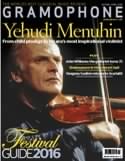Texte paru dans: / Appeared in: |
|
 |
Outil de traduction (Très approximatif) |
|
Reviewer:
Harriet Smith Back in the May 2005 issue of Gramophone, Bryce Morrison extolled the virtues of a Scarlatti disc by a young Russian pianist. His name was Yevgeny Sudbin and it was his debut on BIS. Ten years on, Sudbin decided it was time for another instalment: 18 more sonatas, as enterprisingly and imaginatively programmed as on that first disc.
In the playing itself, there’s the same familiar mix of virtuosity and refinement that marked out the first CD. Sudbin embraces the full resources of his Steinway Model D to recreate this music for a modern age, describing what he does in his eloquent booklet essay as ‘in effect a piano transcription’. Just as Horowitz had his pianos doctored to create the right sound and reactivity for Scarlatti’s unique musical vision, so Sudbin changes textures, shifts phrases up an octave and avails himself of the sustaining pedal in a way that will have purists fleeing for cover. Yet even they should perhaps give pause before rejecting such vitally alive musicianship.
The opening ‘Fuga’, Kk417, becomes a miniature symphony in scope, from its fervently enunciated opening scale through to the Sudbin-enhanced orchestral richness of its closing moments. Repeats are never merely that – he’s not content simply to add ornamentation or change a dynamic; instead we get a sense of true development. This might sound contrived on paper, and could well have been in the hands of a lesser musician, but Sudbin is an artist of rare refinement, as he constantly demonstrates here. He pushes the boundaries, yes, but never simply for shock effect. Just listen to what he does in the first half of the A major Sonata, Kk208, where what was a simple crotchet accompaniment in the left hand suddenly wakes up in the repeat and starts a dialogue with the right. It works because, without a score in front of you, it’s hard to tell what is the work of the composer and what the pianist, so naturally do the two combine. Scarlatti’s sonatas were the food of Sudbin’s youthful studies in Russia (‘he was almost considered a “Russian” composer since his sonatas were standard repertoire for any student at the conservatories and music schools’) – and it shows in his sense of complete familiarity with the music, one that allows him tremendous freedom.
Each piece offers fresh delights: Sudbin’s C major Sonata, Kk159, is extraordinary for its range of colour – the way he gives the opening horn calls a delicate haze of pedal the second time around, and adds ornamentation that in less subtle hands would be merely outlandish, yet which he carries off with aplomb. In the same sonata, Angela Hewitt, on her recent disc, sounds merely careful by comparison.
Some might find that the poignancy of the F minor Sonata, Kk69, comes across most powerfully when played simply (by Anne Queffélec, for example, or Marcelle Meyer), yet Sudbin’s view of it as an operatic scena of the utmost tension is endlessly fascinating. Again, turn to Hewitt’s recent performance and what’s striking is that, though Sudbin is much more radical, Hewitt is the one who sounds less natural. He follows this piece with the restlessly brilliant Kk425 – a minefield for anyone not at the top of their game – in which he conveys not only virtuosity but a confiding quality too.
He shares with Horowitz an ability to conjure up landscapes and narratives within these sonatas, so vividly and intensely are they etched. The rarely played Kk99 is given time to unfold expansively, its moments of Spanishry given with due generosity, while the downwards-rushing scales of the G minor Sonata, Kk373, are vibrantly given. Scarlatti’s famously treacherous repeated notes clearly hold no fears either, no matter how fast the tempo marking: just sample what he does in Kk29, 125 and 141, in the last of these outplaying even Pletnev, which is no mean feat.
And even in a piece as well known as Kk9, one of the highlights on Queffélec’s disc, Sudbin finds a rare lightness and dexterity that leaves most others sounding ponderous. When he starts to play with things even more in the second half, it’s astonishing and utterly mesmerising. The result could have been show-offy, and it’s a tribute to his pianism and musicality that it doesn’t sound that way at all.
The triumph of this disc is not
that it makes you think ‘what wonderful playing’, but ‘what wonderful sonatas’.
Again and again you marvel at Scarlatti’s endless invention. And, tellingly,
Sudbin ends on a profound note with the tenderly inward Kk32, again given a
lusciously vocal quality, which is beautifully captured by BIS’s sensitive
recording. A winner. |
|
|
|
|
|
Cliquez l'un ou l'autre
bouton pour découvrir bien d'autres critiques de CD |
|




